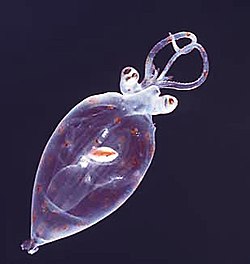| Decapodiformes Temporal range: | |
|---|---|
 | |
| Planktonic cranch squid paralarva; Antarctica | |
| Scientific classification | |
| Kingdom: | Animalia |
| Phylum: | Mollusca |
| Class: | Cephalopoda |
| Division: | Neocoleoidea |
| Superorder: | Decapodiformes Leach, 1817 [2] |
| Synonyms | |
| |
Decapodiformes is a superorder of Cephalopoda comprising all cephalopod species with ten limbs, specifically eight short arms and two long tentacles. It is hypothesized that the ancestral coleoid had five identical pairs of limbs, and that one branch of descendants evolved a modified arm pair IV to become the Decapodiformes, while another branch of descendants evolved and then eventually lost its arm pair II, becoming the Octopodiformes.